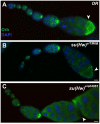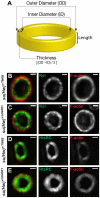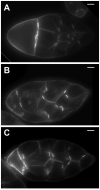The insulator protein Suppressor of Hairy wing is required for proper ring canal development during oogenesis in Drosophila
- PMID: 25882370
- PMCID: PMC4981481
- DOI: 10.1016/j.ydbio.2015.03.024
The insulator protein Suppressor of Hairy wing is required for proper ring canal development during oogenesis in Drosophila
Abstract
Chromatin insulators orchestrate gene transcription during embryo development and cell differentiation by stabilizing interactions between distant genomic sites. Mutations in genes encoding insulator proteins are generally lethal, making in vivo functional analyses of insulator proteins difficult. In Drosophila, however, mutations in the gene encoding the Suppressor of Hairy wing insulator protein [Su(Hw)] are viable and female sterile, providing an opportunity to study insulator function during oocyte development. Whereas previous reports suggest that the function of Su(Hw) in oogenesis is independent of its insulator activity, many aspects of the role of Su(Hw) in Drosophila oogenesis remain unexplored. Here we show that mutations in su(Hw) result in smaller ring canal lumens and smaller outer ring diameters, which likely obstruct molecular and vesicle passage from nurse cells to the oocyte. Fluorescence microscopy reveals that lack of Su(Hw) leads to excess accumulation of Kelch (Kel) and Filament-actin (F-actin) proteins in the ring canal structures of developing egg chambers. Furthermore, we found that misexpression of the Src oncogene at 64B (Src64B) may cause ring canal development defects as microarray analysis and real-time RT-PCR revealed there is a three fold decrease in Src64B expression in su(Hw) mutant ovaries. Restoration of Src64B expression in su(Hw) mutant female germ cells rescued the ring phenotype but did not restore fertility. We conclude that loss of su(Hw) affects expression of many oogenesis related genes and down-regulates Src64B, resulting in ring canal defects potentially contributing to obstruction of molecular flow and an eventual failure of egg chamber organization.
Keywords: Chromatin insulators; Drosophila; Oogenesis; Ring canals; Src64b; Su(Hw); Suppressor of Hairy wing.
Copyright © 2015 Elsevier Inc. All rights reserved.
Figures








Similar articles
-
Mutations in the insulator protein Suppressor of Hairy wing induce genome instability.Chromosoma. 2020 Dec;129(3-4):255-274. doi: 10.1007/s00412-020-00743-8. Epub 2020 Nov 2. Chromosoma. 2020. PMID: 33140220
-
The insulator protein Suppressor of Hairy-wing is an essential transcriptional repressor in the Drosophila ovary.Development. 2013 Sep;140(17):3613-23. doi: 10.1242/dev.094953. Epub 2013 Jul 24. Development. 2013. PMID: 23884443 Free PMC article.
-
The role of the Suppressor of Hairy-wing insulator protein in Drosophila oogenesis.Dev Biol. 2011 Aug 15;356(2):398-410. doi: 10.1016/j.ydbio.2011.05.666. Epub 2011 May 30. Dev Biol. 2011. PMID: 21651900 Free PMC article.
-
Genetic and molecular analysis of the gypsy chromatin insulator of Drosophila.Proc Natl Acad Sci U S A. 1996 Sep 3;93(18):9378-83. doi: 10.1073/pnas.93.18.9378. Proc Natl Acad Sci U S A. 1996. PMID: 8790337 Free PMC article. Review.
-
The Vast Utility of Drosophila Oogenesis.Methods Mol Biol. 2023;2626:1-36. doi: 10.1007/978-1-0716-2970-3_1. Methods Mol Biol. 2023. PMID: 36715897 Review.
Cited by
-
Subcellular Specialization and Organelle Behavior in Germ Cells.Genetics. 2018 Jan;208(1):19-51. doi: 10.1534/genetics.117.300184. Genetics. 2018. PMID: 29301947 Free PMC article. Review.
-
The insulator protein BEAF-32 is required for Hippo pathway activity in the terminal differentiation of neuronal subtypes.Development. 2016 Jul 1;143(13):2389-97. doi: 10.1242/dev.134700. Epub 2016 May 25. Development. 2016. PMID: 27226322 Free PMC article.
-
Transcriptomic data from panarthropods shed new light on the evolution of insulator binding proteins in insects : Insect insulator proteins.BMC Genomics. 2016 Nov 3;17(1):861. doi: 10.1186/s12864-016-3205-1. BMC Genomics. 2016. PMID: 27809783 Free PMC article.
-
Coordinating Proliferation, Polarity, and Cell Fate in the Drosophila Female Germline.Front Cell Dev Biol. 2020 Feb 4;8:19. doi: 10.3389/fcell.2020.00019. eCollection 2020. Front Cell Dev Biol. 2020. PMID: 32117961 Free PMC article. Review.
References
-
- AGALIOTI T, LOMVARDAS S, PAREKH B, YIE J, MANIATIS T, et al. Ordered recruitment of chromatin modifying and general transcription factors to the IFN-beta promoter. Cell. 2000;103:667–678. - PubMed
-
- BATE M, MARTINEZ ARIAS A. Cold Spring Harbor Laboratory. Cold Spring Harbor; N.Y.: 1993. The development of Drosophila melanogaster.
-
- BENJAMINI Y, HOCHBERG Y. Controlling the False Discovery Rate - a Practical and Powerful Approach to Multiple Testing. Journal of the Royal Statistical Society Series B-Methodological. 1995;57:289–300.
-
- BRASSET E, VAURY C. Insulators are fundamental components of the eukaryotic genomes. Heredity. 2005;94:571–576. - PubMed
Publication types
MeSH terms
Substances
Grants and funding
LinkOut - more resources
Full Text Sources
Other Literature Sources
Molecular Biology Databases
Miscellaneous

